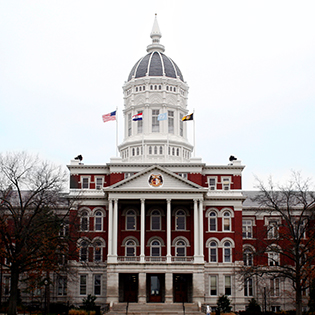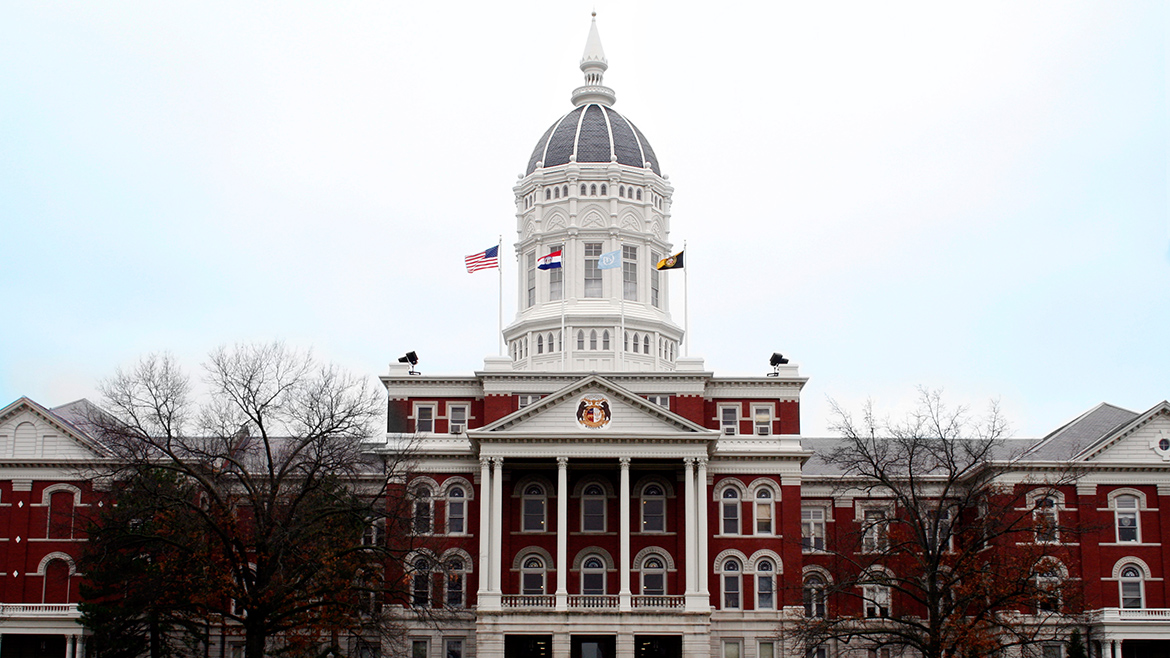A Calm Between Storms

 For months, it seemed like the bad old days of the ’60s and ’70s had returned to the University of Missouri campus. Starting in 1965, Old Mizzou was roiled by a series of controversies that began as students — inspired, no doubt, by activities elsewhere — challenged the university’s role as their in loco parentis. The protests reached a crescendo during a series of demonstrations in May 1970 after the Kent State shootings that led to censure by the American Association of University Professors in April 1973. Statewide and legislative sentiment vis-a-vis the university had reached a historic nadir, resulting in funding cuts that proved harmful. As the Vietnam War de-escalated, a sense of normalcy gradually returned to the campus. One expression of relief came in March 1974, when thousands of students streaked across campus in an active week of near-naked activity that included one student’s historic bareback sally through Greektown on a white horse.
For months, it seemed like the bad old days of the ’60s and ’70s had returned to the University of Missouri campus. Starting in 1965, Old Mizzou was roiled by a series of controversies that began as students — inspired, no doubt, by activities elsewhere — challenged the university’s role as their in loco parentis. The protests reached a crescendo during a series of demonstrations in May 1970 after the Kent State shootings that led to censure by the American Association of University Professors in April 1973. Statewide and legislative sentiment vis-a-vis the university had reached a historic nadir, resulting in funding cuts that proved harmful. As the Vietnam War de-escalated, a sense of normalcy gradually returned to the campus. One expression of relief came in March 1974, when thousands of students streaked across campus in an active week of near-naked activity that included one student’s historic bareback sally through Greektown on a white horse.
A different sense of calm has returned to the campus as this is written. Concern remains as university administrators are confronted by the looming financial challenges posed by projected enrollment declines and whatever spanking the solons in Jefferson City decide to inflict as a reflection of increasingly negative sentiment statewide. It has never been easy for the University of Missouri, which now receives almost a half-billion dollars every year in appropriations from the state legislature. Conflict arises because the majority of those who toil in academia consider themselves to be liberals, progressives, perhaps even socialists. They reliably vote for Democratic candidates, much to the consternation of Republicans, libertarians, conservatives, tea partiers and whatever else now constitutes their virtually veto-proof majorities in both houses.
Right now, there doesn’t seem to be much room for compromise in Jefferson City. The Republicans — the conservatives, if you will — are running the legislative show, and some of them speak rather vengefully of our flagship campus. Legislators have foolishly negated any effort to fully staff the UM Board of Curators until after the November general election just when it would seem that full strength would be most helpful in rebuilding the university’s somewhat tattered executive suite. The unintended consequences of their pique could hurt the very folks who need the most help. Perhaps this will lead to the reduction of their super majorities when enough voters react negatively at the polls to their legislative vengeance.
Too much energy has been wasted on the untenured, somewhat less than muscular assistant professor of communications who made a fool of herself November 9. She has since apologized, the civil complaint has been addressed and now she hangs suspended midway in her year-long procedure to gain tenure. MU is in a tight spot here, squeezed between the rabble who wants the lady fired and the delicacy of dealing with the AAUP and their power to sanction, which would lessen Mizzou’s ability to both hire and retain its academic staff. Put the lady back in the classroom and allow the tenure process to determine her fate, unpopular as her reinstatement might be with the hoi polloi. It’s not a good idea to fool around with the AAUP, especially while MU is struggling to remain an invited member of the prestigious American Association of Universities.
Put the lady back in the classroom and allow the tenure process to determine her fate, unpopular as her reinstatement might be with the hoi polloi.
The curators and General Counsel Steve Owens, Esq., should have been more muscular dealing with the volcanic eruption at the meeting on February 4. That’s when a group of black activists interrupted the whittled down assemblage of curators to read and reinforce their demands that were first proffered during The Times of Troubles last fall. The benign reaction to this eruption by the curators is very troubling. Is there not something in “Robert’s Rules of Order” that would have accounted for and controlled this behavior? Or is “Robert’s” irrelevant because disrespectfully boisterous interruptions of otherwise public meetings are something we just better get used to? The protesters should have requested time to speak in advance. Do the curators have any rules of procedure? They should have asked them to leave. If they didn’t comply, they should have been removed, perhaps even arrested if necessary.
Even more troubling is the new twist of angry militancy expressed by the demonstrators who invoked the name of a presumed heroine as they exited their disruptive visit with the curators. This may well be a very ominous development. Invoking and honoring Assata Shakur, a.k.a. Joanne Chesimard, would appear to escalate the militancy of this band of objectors as they continue to press their demands for change at the University of Missouri. Shakur, exiled to Cuba following her escape from a New Jersey prison in 1979, had been convicted of murdering a New Jersey state police officer during a traffic stop in 1973. With a $2 million bounty on her head, she is definitely among the most wanted and represents the antithesis of what most of us would consider to be a law-abiding citizen. Our canary in the coal mine doesn’t like what it sees because something more noxious seems almost certain to develop as the days warm up and protest groups are reactivated.


